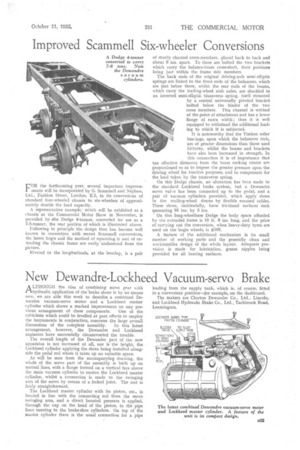New Dewandre-Lockheed Vacuum-servo Brake
Page 37

If you've noticed an error in this article please click here to report it so we can fix it.
A LTHOUGH the idea of combining servo gear Mith In.hydraulic application of the'larake shoes is by no means new, we are able this week to describe a combined Dewandre vacuum-servo motor and a Lockheed master cylinder which shows a marked improvement on any pre vious arrangement of these components. One of the criticisms which could be levelled at past efforts to employ the instruments in conjunction, concerns the large overall
dimensions of the complete assembly. In this latest arrangement, however, the Dewandre and Lockheed engineers have successfully circumvented the trouble.
The overall length of the Dewandre part of the new apparatus is not increased at all, nor is the height, the Lockheed cylinder applying the shoes being installed alongside the pedal rod, where it takes up no valuable space.
As will be seen from the accompanying drawing, the whole of the servo part of the assembly is built up on normal lines, with a flange formed on a vertical face above the main vacuum cylinder to receive the Lockheed master cylinder, whilst a connection is made to the swinging arm of the servo by means of a forked joint. The rest is fairly straightforward.
The Lockheed master cylinder with its piston, etc., is located in line with the connecting rod from the servo swinging arm, and a direct boosted pressure is applied, through the cup on the head of the piston, to the pipe lines running to the brake-shoe cylinders. On top of the master cylinder there is the usual connection for a pipe
leading from the supply tank, which is, of course, fitted in a convenient position—or example,-on the dashboard.
The makers are Clayton Dewandre Co., Ltd., Lincoln. and Lockheed Hydraulic Brake Co., Ltd., Tachbrook Road, Leamington,




























































































